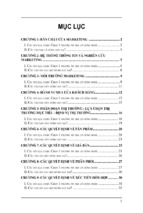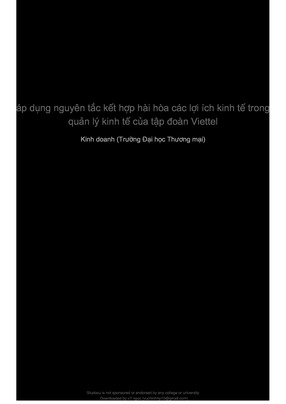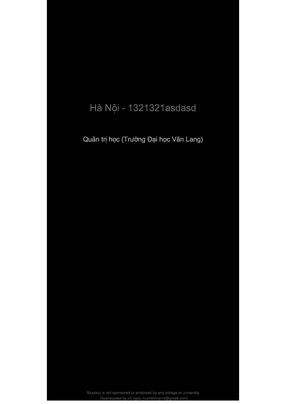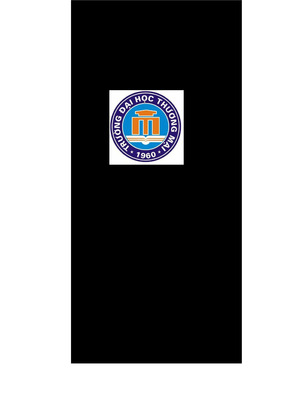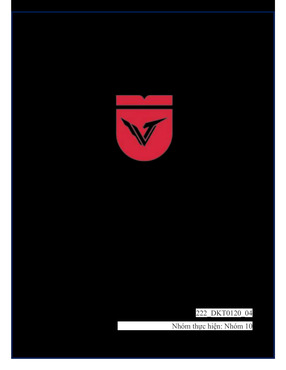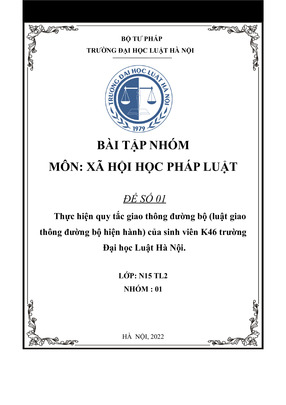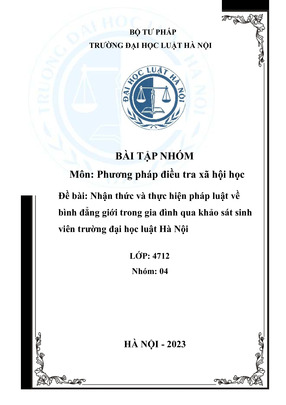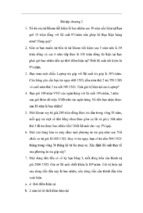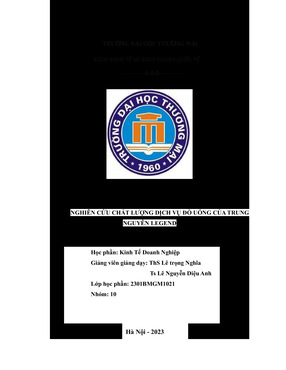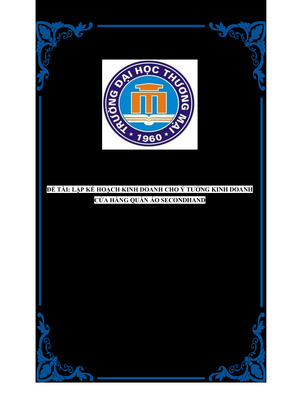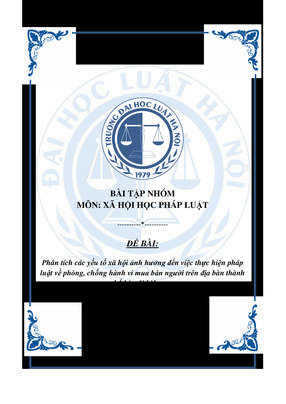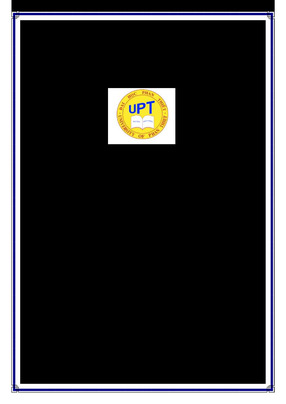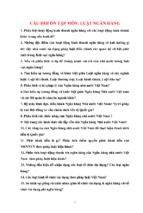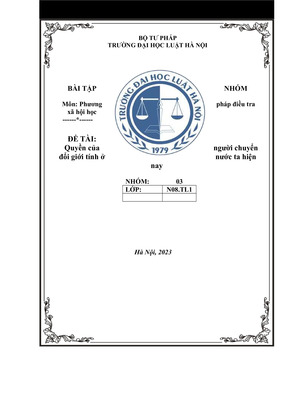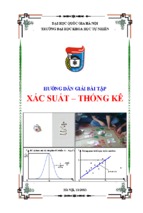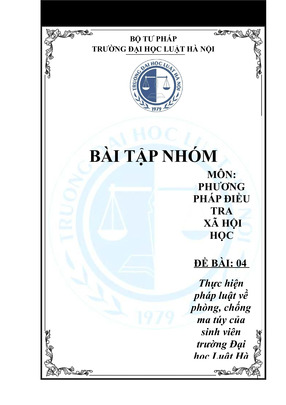MINISTRY OF EDUCATION AND TRAINING
QUY NHON UNIVERSITY
VÕ MỸ THƯ
THE QUALITY OF GOOGLE TRANSLATE'S
VIETNAMESE TRANSLATIONS OF ENGLISH
IDIOMS WITH WORDS DENOTING TIME
Field: English Linguistics
Code: 8.22.02.01
Supervisor: Dr. Le Nhan Thanh
BỘ GIÁO DỤC VÀ ĐÀO TẠO
TRƯỜNG ĐẠI HỌC QUY NHƠN
VÕ MỸ THƯ
CHẤT LƯỢNG DỊCH CÁC THÀNH NGỮ CHỨA TỪ
••
CHỈ THỜI GIAN TỪ TIẾNG ANH SANG TIẾNG
VIỆT CỦA GOOGLE TRANSLATE
Chuyên ngành: Ngôn ngữ Anh
Mã số: 8.22.02.01
Người hướng dẫn: TS. LÊ NHÂN THÀNH
i
STATEMENT OF AUTHORSHIP
I hereby confirm that the thesis entitled “The quality of Google Translate's
Vietnamese translations of English idioms with words denoting time” is the
result of my work except for the reference mentioned in the thesis. This thesis
has not been submitted for any degree or other institutions.
Quy Nhon, October,2020
Performer
Võ Mỹ Thư
ACKNOWLEDGMENTS
The fulfillment of this thesis is thanks to the encouragement and efforts of
many people to whom I would like to pay my gratitude to.
First and foremost, I would like to sincerely express my innermost gratitude to
my supervisor, Dr. Le Nhan Thanh, who I am deeply indebted for the
continuous support, patience, immense motivation, and valuable guidance to
accomplish this work. Without his persistent help, this study could not have
been possible. The knowledge and experience gained from doing the MA
course have been priceless to my studying and career.
Besides, I wish to express my special thanks to all the lecturers who are in
charge of training for the 21st MA course at Quy Nhon University for having
transmitted immense knowledge and creating a friendly and constructive
environment during the course.
I am also extremely thankful to my close friends and colleagues who always
give encouragement and energy to overcome difficulties during the time I
attended the MA course.
Last but not least, I would like to express my profound gratitude to my warmhearted family members for their love, care, and support which are sources of
motivation for me to attempt to complete this thesis.
ABSTRACT
Google Translate is the most pervasive online translation tool used in the
current time. In recent years, there has been an increasing interest in evaluating
the quality of GT in different genres. However, far too little attention has been
paid to GT’s quality in idiom translation; this study aims to investigate the
quality of GT’s Vietnamese translations of English idioms with words
denoting time in terms of translation errors. Accordingly, the study examined
the translation error types committed by GT and their corresponding
frequency. In an attempt to achieve this aim, both the qualitative and
quantitative approaches are employed to analyze the data. GT’s Vietnamese
translations of 128 English idioms with words denoting time were analyzed
based on the conceptual framework on translation error proposed by Nord
(1997) including four types of translation errors: pragmatic errors, cultural
errors, linguistic errors, and text-specific errors. The translation errors found in
GT translations and their occurrences are used for translation quality
assessment. The results indicate that GT could not achieve the expected
accuracy in translating pure and semi idioms with figurative meanings, and GT
shows better quality in translating literal idioms than pure idioms. In addition,
among the four translation error types, pragmatic errors are the most common
error committed by GT in Vietnamese translations of English idioms. Some
suggestions and implications are proposed for teachers and students majoring
in translation, translators, and researchers who are interested in the related
field.
TABLE OF CONTENTS
STATEMENT OF AUTHORSHIP ................................................................ i
ACKNOWLEDGMENTS.................................................................................ii
ABSTRACT ....................................................................................................iii
ABBREVIATIONS......................................................................................... vi
LIST OF TABLES .......................................................................................... vii
CHAPTER 1. INTRODUCTION ................................................................ 1
1.1. RATIONALE ......................................................................................... 1
1.2. AIM AND OBJECTIVES OF THE STUDY.......................................... 3
1.2.1...............................................................................................................Ai
m ...................................................................................................................... 3
1.2.2.Objectives ........................................................................................... 3
1.3. RESEARCH QUESTIONS .................................................................... 3
1.4. SCOPE OF THE STUDY ...................................................................... 4
1.5. SIGNIFICANCE OF THE STUDY ....................................................... 4
1.6. ORGANIZATION OF THE STUDY .................................................... 5
CHAPTER 2. LITERATURE REVIEW .................................................... 7
2.1. Translation .............................................................................................. 7
2.1.1. Definition ......................................................................................... 7
2.1.2. Translation process .......................................................................... 9
2.1.3. Types of translation .......................................................................... 11
2.1.4. Machine translation......................................................................... 14
2.1.5. Google Translate............................................................................. 16
2.1.6. Translation errors ............................................................................. 19
2.1.7. Translation Quality Assessment ....................................................... 25
2.2. Idioms ..................................................................................................... 27
2.2.1. Definitions of idioms ....................................................................... 27
2.2.2. Classification of idioms ................................................................... 29
2.2.3. Idioms denoting time ....................................................................... 31
2.2.4. Idioms translations .......................................................................... 31
2.3. Previous studies....................................................................................... 33
CHAPTER 3. METHODOLOGY ................................................................. 37
3.1. Research methods ................................................................................. 37
3.2. Data collection ...................................................................................... 39
3.3. Data analysis ......................................................................................... 43
CHAPTER 4. FINDINGS AND DISCUSSION ........................................ 46
4.1. Translation errors in Google Translate’s Vietnamese translations of
English idioms.................................................................................................46
4.1.1. No translation errors ........................................................................47
4.1.2. Pragmatic translation errors .............................................................50
4.1.4. Cultural translation errors ................................................................57
4.1.5. Text-specific translation errors ........................................................62
4.1.6. Special cases in translation errors.....................................................65
4.2. Frequency of translation error types in Google Translate’s Vietnamese
translations according to idiom types..............................................................68
CHAPTER 5. CONCLUSIONS AND IMPLICATIONS......................... 71
5.1. Summary of findings .............................................................................71
5.2. Limitations..............................................................................................73
5.3. Implications ............................................................................................74
5.4. Suggestions for further research ............................................................75
REFERENCES
APPENDICES
ABBREVIATIONS
CE
cultural translation errors
GT
Google Translate
IT
idioms with words denoting time
LE
linguistic translation errors
LI
literal idioms
MT
Machine Translation
NE
no error
PE
pragmatic translation errors
PI
pure idioms
SI
semi-idioms
SL
source language
TE
text-specific translation errors
TL
target language
TQA
translation quality assessment
LIST OF TABLES
Number
Names of tables
Table 2.1 109 languages supported by Google Translate (Google
2020)
Table 2.2 Identifiable characteristics of translation errors
Table 2.3 Types of idioms (McCarthy and O’Dell, 2003, p.6)
Table 3.1 Sample Data Storage (English Idioms and Vietnamese
translations from Google Translate in sentences)
Table 3.2 Translation errors for analyzing with reference
examples
Table 3.3 The numbers of errors translation in each idioms types
committed by GT
Table 4.1 Occurrences of translation errors types committed by
GT
Table 4.2 The number of occurrences of no translation errors in
each idiom type
Table 4.3 The number of occurrences of the pragmatic errors in
each idiom type
Table 4.4 The number of occurrences of linguistic translation
errors in each idiom type
Table 4.5 The number of occurrences of cultural errors in each
idiom type
Table 4.6 The number of occurrences of the Text-specific
translation errors in each idiom type
Table 4.7 The number of translation errors in each idiom type
committed by GT
Page
18
25
30
42
44
45
47
47
50
55
58
63
68
LIST OF FIGURES
Number
Figure 2.1
Figure 2.2
Figure 2.3
Figure 2.4
Names of figures
Translation process (Larson, 1984, p. 4)
Timeline of MT evolution (Maucec & Donaj, 2019)
Google Translate graphical user interface
Classification of translation errors (Vilar et al., 2006,
p. 699)
Figure 4.1
Occurrences of translation errors according to
idioms types
Page
9
14
17
21
69
1
CHAPTER 1
INTRODUCTION
1.1.
Rationale
Along with the globalization and technological advances, the need for
international understanding is considerably increasing. However, language
barriers hinder most people from understanding the messages from native
speakers. Translation, therefore, is considered as a key role to bridge the
communication gap in various fields such as education, science and
technology, literature, tourism, trade and business. Translation can be
understood as a process of transferring the content of a text from the source
language (SL) into the target language (TL).
With the growing requirements in translation, many translation tools
have become the top priority for most people when encountering problems in
communicating. Many automated translation applications have been proposed.
Among these, Google Translate (GT) is the most popular machine translation
used since it can translate tremendous amounts of information in a second with
low cost and security. The term Google Translation refers to a translation
service developed by Google in April 2006. It translates multiple forms of texts
and media such as words, phrases, and webpages. Today Google Translate
supports over 100 languages at various levels. This advanced tool makes it
possible for global communication.
Although GT is extensively used, the quality of GT output has always
been a great concern. Due to the linguistic and cultural differences between
languages, the practice of translation has shown the limit in generating target
sources naturally, fluently, and comprehensibly especially when dealing with
idiomatic expressions. Amir (2012) explained that since the meaning of idioms
cannot be understood from the superficial meanings of the single words
2
constituting them, there are some problems in both processes of understanding
and translating them. Therefore, the quality of GT outsources in idioms
translations need to be paid more attention.
Recently, researchers have shown an increasing interest in investigating
the quality of GT. For example, Jimmy Cromico (2015) examined Translation
quality of English-Indonesian by using Google Translate with the results that
Google Translate cannot determine suitable techniques to produce a quality
translation in translating sentences found on scientific articles. Also, Aiken and
Balan (2013) conducted a study on An analysis of Google Translate accuracy
and found that translations among Western languages by GT are typically
better than those in Asian languages. Another study published by Shao et al.
(2018) evaluated Machine Translation Performance on Chinese Idioms with a
Blacklist Method, the results proved that GT generates relatively poor quality
in Chinese idioms translations and literal translation error is a common error
type.
Although several attempts have been made to evaluate GT quality, most
of them have tended to focus on investigating the quality of GT in the whole
text among pairs of languages having nearly the same linguistic features. There
are only a few that evaluate GT performances in specific terms like idioms in
the language pair English and Vietnamese. Since idioms make part of
figurative expressions in language, they are frequently used in daily
conversation, school materials, newspapers, media, etc. Despite recent
development in the field of translation theory and application, idiomatic
expressions still pose a serious challenge for translators as well as machine
translation.
This study seeks to obtain data that will help to address these research
gaps. My interest in this area developed while I usually encounter idiomatic
3
expressions in the reading academic materials and the mass media. The
strengths of idioms in better-expressing emotions and contextual meanings
have inspired me to explore this field.
With the aim to give insights into the quality of idioms translation
committed by GT, this study attempts to identify the errors performed by GT
when it translates English idioms with words denoting time. The quality of GT
is then explored. This is the reason why I decided to do the research on: “The
quality of Google Translate's Vietnamese translations of English idioms with
words denoting time.”
1.2.
Aim and objectives of the study
1.2.1. Aim
This study aims to examine the quality of Google Translate’s Vietnamese
translations of English idioms with words that denote time.
1.2.2. Objectives
To achieve this aim, the researcher collected and analyzed data to fulfill the
following objectives:
- Identify the errors committed by Google Translate when it translates English
idioms with words denoting time into Vietnamese,
- Classify the errors according to translation error types, and
- Examine the frequencies of the errors in terms of translation error types.
1.3.
Research questions
Based on the background of the research, the researcher attempted to answer to
the following questions:
1. What errors can be found in Google Translate’s Vietnamese translations
of the English idioms with words that denote time?
2. What kinds of errors can be found in Google Translate’s Vietnamese
translations of these English idioms?
4
3. What is the frequency of each of the translation error types found in
Google Translate’s Vietnamese translations of these English idioms?
1.4.
Scope of the Study
This study focuses on investigating the errors found in idiomatic
expressions translation results committed the online translation tool - Google
Translate. In this study, 128 English sentences containing idioms with words
denoting time were collected from the reliable paper dictionary “Oxford
Dictionary of Idioms” (Siefring, 2004), and four online dictionaries
https://www.theidioms.com,
https://idioms.thefreedictionary.com/, https://dictionary.cambridge.org, and
https://www.oxfordlearnersdictionaries.com,
This research was restricted to English idioms that contain words
pertaining to time expressions with their corresponding Vietnamese
translations by GT. Other linguistic types of idioms without time-related
meaning are excluded to be examined in the research.
With regard to reliability, the reference source for collecting data, as
mentioned above are all prestigious supply with a vast amount of idioms
available. Idioms with words denoting time (IT) were the criteria for collecting
since time concept is predominant in Western culture. Therefore, its popularity
in idioms gives a possible corpus for this study.
1.5.
Significance of the Study
The results of the study will be of great benefits in two aspects.
Theoretically, the findings of the study will hopefully provide knowledge
about the quality of GT’s translations of English - Vietnamese idiomatic
expressions. Moreover, this research also provides references for errors made
by GT for other researchers to conduct further related researches.
In terms of practice significance, the results of the study suggest some
5
implications for teachers, students, and especially those working in the
translation field. Specifically, it helps teachers to figure out translation errors
of GT in idioms translations, so they can avoid such problems and be more
selective when utilizing GT. At the same time, they can train students in
translating idioms as well as using GT in effective ways. As regards students,
this study gives insights into idioms and idioms translation by humans and GT.
Knowledge about idioms makes them more flexible in linguistic skills in
school performances as well as daily conversations with foreigners. In
addition, it also gives the references for linguists and computer experts to
improve Google Translate’s quality in idioms translations by building the
parallel corpora for bilingual English-Vietnamese idiomatic expressions of
statistical machine translation in the future.
1.6.
Organization of the study
The six chapters in this dissertation are organized as follows:
Chapter 1: Introduction - presents the rationale for the study, aim, and
objectives of the study, the research questions, and the scope of the study.
Chapter 2: Literature review - focuses on introducing important concepts of
translation, Machine Translation, Google Translate, Translation Errors theory,
and idioms relevant to the topic of the study; presents the theoretical
framework for later data analysis and reviews the previous studies related to
the topic of this thesis.
Chapter 3: Methodology - presents the chosen research method and research
procedures for carrying out the study.
Chapter 4: Findings and Discussion - examines, identifies, describes and
analyzes the types of errors; reports and discusses the results of data analysis
Chapter 5: Conclusions and Implications - summarizes the main findings of
the study and provides some implications for English translations, English
6
learning and teaching. This chapter also includes the limitations and
suggestions for further researches.
CHAPTER 2 LITERATURE REVIEW
This chapter provides a brief overview of the theoretical background including
translation, machine translation, Google Translate, translation errors, translation
quality assessment, and idioms. A review of previous studies related to the topic
is mentioned in this chapter as well.
2.1.
Translation
This section covers the theory about translation consisting of the definition of
translation, translation process, types of translation, machine translation, Google
Translate, translation errors, and translation quality assessment.
2.1.1. Definition
Translation has been viewed differently by translation theorists.
Translation can be defined as “the replacement of textual material in one
language (source language) by an equivalent textual material in other language
(target language)” (Catford, 1965, p.20). Catford mentioned equivalence from
the linguistic aspect. It means only equivalence on the level of the surface
structure of language is emphasized without concerning to the intended meaning,
the target reader, or the styles of the translated text.
Meanwhile, Nida (1974) defined translation as “a process of reproducing
in the target language the closest natural equivalent of the source language
message, first in terms of meaning and secondly in terms of styles”. This view is
supported by Bell (1991) who found that translation is the expression in another
language (target language) of what has been expressed in another (source
language) preserving semantic and stylistic equivalences.
With this definition, translation focuses on the response of the receptor. In other
words, remaining message or meaning is the principle when rendering from SL
to TL.
In line with this notion, Newmark (1988) emphasized the meaning element in
translation rather than linguistic equivalences. He noted that translation is
rendering the meaning of a text into another language in the way that the author
intended the text.
A broader perspective has been adopted by Bell (1991) who found that
translation is the expression in another language (target language) of what has
been expressed in another (source language) preserving semantic and stylistic
equivalences. This view is supported by House (1977) who explained that
translation is the replacement of a text in the source language by a semantically
and pragmatically equivalent text in the target language. With this notion, the
translation process mainly involves semantic and pragmatic aspects.
From the definitions mentioned above, it can be concluded that receptors will
understand an idea in relatively the same way as the intended messages when the
translation process deals with three main principles reproducing, transferring,
and maintaining the original message of the source language. Translation is a
complicated process, so the quality of target translations may not be evaluated
perfectly. To generate a relatively accurate translation, translators are supposed
to grasp a huge knowledge of multi-dimension such as society, culture, and
linguistics.
According to Arnold et al. (1994), a human translator requires five kinds of
knowledge:
- Knowledge of the source language
- Knowledge of the target language
- Knowledge of various correspondences between the source language and
target language
- Knowledge of the subject matter, including general knowledge and
“common sense”
- Knowledge of the culture, social conventions, customs, and expectations,
etc. of the speakers of the source and target language.
Therefore, translators are supposed to master knowledge on semantics and
pragmatics to maintain the original message of the source language.
This section reviews some definitions of translation viewed from different
aspects of linguistics as well as required knowledge for a translator. The next
part describes the procedures in translation work
2.1.2. Translation process
As the process of communication, the translation process involves the
transferring of the message from the source language (SL) into the receptor
language (RL). Larson (1984) describes translation as a meaning-based process
that refers to the usage of both grammatical and choice of lexical items of the
receptor language.
Larson described the procedure of translation in three steps: (1) examining the
lexicon, grammatical structure, communication situation, and cultural context of
the source language text, (2) analyzing the source language text to determine its
meaning, (3) then reconstructing the same meaning by using the lexicon and
grammatical structure which is appropriate in the target language and cultural
context. The overview of this process is demonstrated in Figure 2.1.
Source Language
Text to be translated
Discover the meaning
Receptor Language
Translation
1
Re-express the meaning
Meaning
Figure 2.1. Translation process (Larson, 1984, p. 4)
However, the above-mentioned process is a very simple and general overview of
the process of translation. This process is definitely complicated. According to
Larson (1984, pp.519-526), translation procedure is divided into 8 steps as
follows:
1. Preparation: the translator should have trained in linguistics knowledge and
translation principle before undertaking the project. Then, preparation steps
including reading the entire texts, studying the background material, studying
linguistic matters are followed to get familiar with the text.
2. Analysis: the translator should have to take note of any lexical item as the
keywords and pay attention to the opening and closing of the text to identify the
theme of the original language.
3. Transfer: it is a process of analyzing the semantic structure of the initial draft
in the translation. In this process, the translator attempts to find out the lexical
equivalence and culture in the receptor language.
4. Initial Draft: the translator had lelt the draft for a certain time to get more
reading background for the best equivalent and then back for reworking on them
5. Reworking the Initial Draft: translator checks for accuracy and naturalness
with the focus on the meaning of language. After the translators get a second
draft and translator might work out again and again to modify the draft until they
finish a final draft.
6. Testing the Translation: this step involves testing the translation by translators
themselves or with the help of other members who are trained as expert
consultants.
7. Polishing the Translation: From the results of, translators should have to
check again and polish the translation in order to ensure the accuracy,
naturalness, and acceptability in the receptor language
8. Preparing the Manuscript for the Publisher: this is the last step of the
translation process. After the final draft is completed, the manuscript is ready to
be prepared for the publisher.
- Xem thêm -


